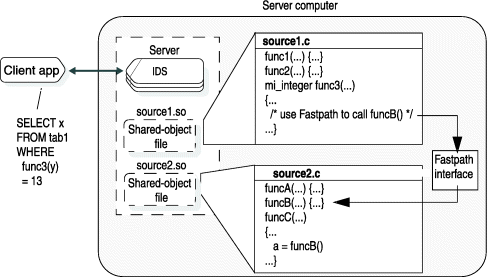Call UDRs with the Fastpath interface
With the DataBlade® API Fastpath interface, DataBlade® API modules can directly invoke a UDR that was registered in the database. This interface bypasses the overhead associated with invoking a UDR through an SQL statement. This interface bypasses the query optimizer and executor, which are needed for an SQL statement. You can use this interface to execute any SQL routine.
- You do not know the location of the UDR you want to call.
- At compile time, you do not know the name of the UDR you want to call.
- You need to promote or cast arguments of the UDR you want to call.
- The UDR you want to call is an overloaded routine and you need to obtain the version for particular argument data types.
- The UDR you want to call is in a different shared-object file or DataBlade®. (Server only)
The Fastpath interface looks up a UDR or cast function in the system catalog tables to obtain information about the routine and then executes it. It passes any return values from the routine to the caller in internal (binary) format. With the Fastpath interface, a DataBlade® API module can call a foreign UDR.
For a C UDR, a foreign UDR is a UDR that is not in the same shared-object file as the UDR that calls it. One UDR can only call another UDR directly when that called UDR is within the same shared-object file or DataBlade® module as the calling UDR. For example, in Calling a UDR directly from another UDR, the func3() user-defined function can directly call func2() because both of these functions are in the source1.so shared-object file.
However, there is no portable way for the C code in one shared-object file to directly call a function in another shared-object file. Different operating systems provide different degrees of support for this type of calling. In addition, if the foreign UDR is part of a DataBlade® module, your UDR has no way of knowing which DataBlade® modules might be installed at a particular customer site.

In preceding figure, the Fastpath interface loads the source2.so shared-object file, which contains the funcB() routine, into memory. For Fastpath to be able to invoke funcB(), the funcB() routine must already have been registered in the database. The call to funcB() within funcC() does not require use of the Fastpath interface because these two functions are in the same shared-object file, source2.so.
The Fastpath interface allows a DataBlade® developer to extend a DataBlade® module that someone else provides. This developer can define new UDRs on data types that some other DataBlade® provides.
For a client LIBMI application, a foreign UDR is any UDR that is registered in the database that is currently open. Client LIBMI programs can use the Fastpath interface to directly invoke registered UDRs.
The Fastpath interface provides the following DataBlade® API functions to look up a registered UDR, execute it, and free resources.
| DataBlade® API function | Purpose |
|---|---|
| mi_cast_get() | Looks up a cast function that casts between two data types (specified by type identifiers) and returns its function descriptor |
| mi_func_desc_by_typeid() | Looks up a UDR by its routine identifier and returns its function descriptor |
| mi_routine_get() | Looks up a UDR by its routine signature (specified as a character string) and returns its function descriptor |
| mi_routine_get_by_typeid() | Looks up a UDR by its routine signature (specified as separate arguments) and returns its function descriptor |
| mi_td_cast_get() | Looks up a cast function that casts between two data types (specified by type descriptors) and returns its function descriptor |
| DataBlade® API function | Purpose |
|---|---|
| mi_fparam_get() | Returns a pointer to the MI_FPARAM structure that is associated with the function descriptor |
| mi_func_handlesnulls() | Determines whether the UDR that is associated with the function descriptor can handle NULL arguments |
| mi_func_isvariant() | Determines whether the user-defined function that is associated with the function descriptor is a variant function |
| mi_func_negator() | Determines whether the user-defined function that is associated with the function descriptor has a negator function |
| mi_routine_id_get() | Returns the identifier for the routine that is associated with the function descriptor |
| DataBlade® API function | Purpose |
|---|---|
| mi_routine_exec() | Executes a UDR that is associated with a specified function descriptor |
| DataBlade® API function | Purpose |
|---|---|
| mi_fparam_allocate() | Allocates an MI_FPARAM structure |
| mi_fparam_copy() | Creates a copy of an existing MI_FPARAM structure |
| mi_fparam_free() | Deallocates a user-allocated MI_FPARAM structure |
| mi_fp_usr_fparam() | Determines whether a specified MI_FPARAM has been allocated by the database server or the user |
| DataBlade® API function | Purpose |
|---|---|
| mi_routine_end() | Releases resources that are associated with the function descriptor |